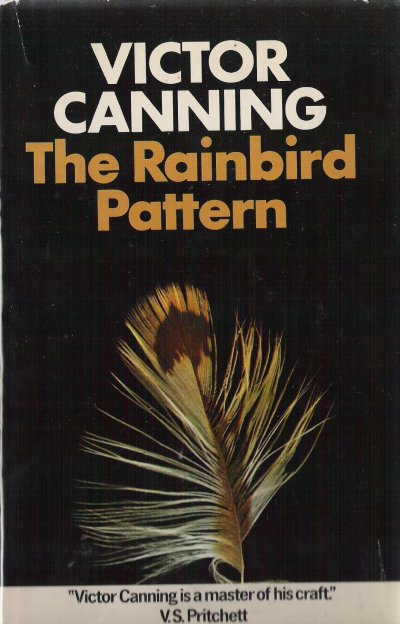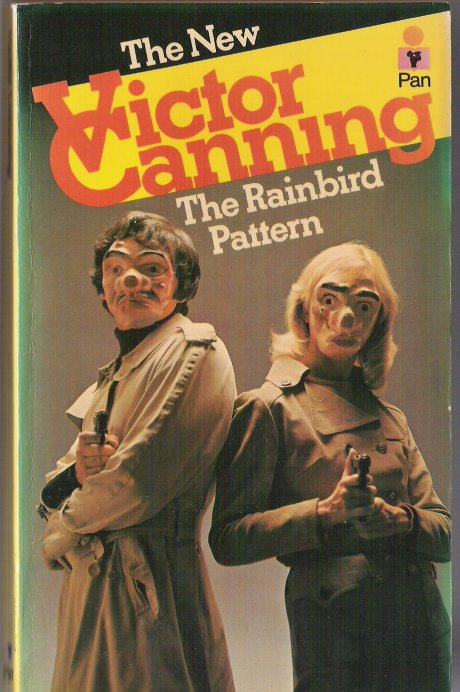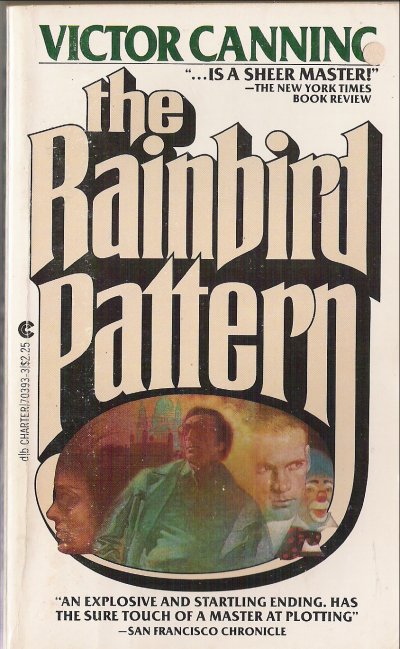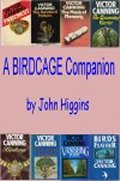
First edition

US first edition

Pan paperback

US paperback

Ostara edition 2010

French translation

Portuguese translation

Birdcage Companion
 First edition |
 US first edition |
 Pan paperback |
 US paperback |
 Ostara edition 2010 |
 French translation |
 Portuguese translation |
 Birdcage Companion |
The BookA criminal signing himself 'Trader' has kidnapped two public figures, both Members of Parliament, for relatively small ransoms, but has made sure there has been press coverage. The handovers of money and victims are arranged with meticulous care, and the authorities are unable to identify the kidnappers. Miss Rainbird, an elderly spinster living in Chilbolton, has engaged a spirit medium, Blanche Tyler or 'Madame Blanche', to track down her illegitimate nephew whom the family sent for adoption forty years before. The medium uses her boyfriend, George Lumley, to make enquiries in the village, the results of which she can later present as spirit communications, so George sets out to find the nephew and eventually identifies him as Edward Shoebridge. A lucky accident gives Blanche Eddie Shoebridge's address. Meanwhile 'Trader' prepares his biggest coup, the kidnapping of the Archbishop of Canterbury without publicity and for a vast ransom. Blanche sets out to meet the Shoebridges, her psychic abilities giving her no inkling of the danger she is walking into. The ending is quite unexpected and sinister. |
Publishing HistoryOne of the finest thrillers ever written, it was published by Heinemann in 1972 at £1.90 and by Morrow in the USA in 1973 at $6.95. There was a Companion Book Club edition in 1973 and a Pan paperback in 1974. It was awarded the Silver Dagger of the Crime Writer's Association (UK) in 1973 and was nominated for the Edgar award in the USA in 1974. A new edition by Ostara Publishing has been issued (November 2010) in its Top Notch Thrillers series. It is set mainly in the village of Chilbolton in Hampshire, at the Army Aviation Centre at Middle Wallop in Hampshire, in and around Salisbury in Wiltshire, and near Blagdon in north Somerset. This was Canning's masterpiece, a beautifully characterised and plotted story, drawing out two of the main Canning themes: love for the rural landscape, and the equal ruthlessness of criminals and law enforcers, with harmless if not entirely innocent bystanders crushed between them. The description of the working practices of a spirit medium is quite brilliant, exposing the mixture of deception and self-deception which is necessary to her trade. The book relies on the central mechanism of narrating two almost parallel sets of events which are bound to intersect; we can see that a collision is coming and would love to warn the characters, but are as powerless as a pantomime audience calling "Behind you!". Note: I sometimes think the weakest thing about the book is its title. In the sixties Canning had written a series of short stories about a fictional "Department of Patterns" in the French Sûreté, with titles like "The Doomsday Pattern" and "The Carnation Pattern". I suspect that when he started writing the book he used "The Rainbird Pattern" as a working title until he could think of something better. Somehow it got through to the published version. In this respect, at least, Hitchcock improved on the original, with a punning reference to the graveyard in which George starts his hunt for the Rainbird family secrets. Two interesting online reviews have been posted by bloggers, one by Existential Ennui and one by Clothes in Books. |
The film: Family Plot (1976)The Rainbird Pattern was apparently introduced to Alma Hitchcock by William Link, best known as the producer of the Columbo TV detective series, who thought Alfred Hitchcock would be intrigued by the parallel narrative strands. The film version, Family Plot, starts fairly close to the book, but then turns into a completely different story with a conventional happy ending as Blanche and George catch the kidnappers and find the ransoms. The treatment suffers, too, by being set in the USA where there is no figure to kidnap who is quite comparable to the Archbishop of Canterbury; one can't get quite so worked up about "Bishop Wood". The film contains reprises of some classic Hitchcock set pieces, such as the sabotaged car careering down a mountain road, followed by the the would-be murderer trying to run down George and Blanche on the deserted road. Significantly, the scriptwriter, Ernest Lehman, was the scriptwriter for North By Northwest. This was Hitchcock's last completed film. Cast: Barbara Harris as Blanche Tyler, Bruce Dern as George Lumley, Karen Black as Fran and William Devane as Arthur Adamson (replacing the Shoebridges of the book), and Catherine Nesbitt as Julia Rainbird Canning himself disliked the film and, according to his godson Charles Collingwood, "washed his hands of it". Hitchcock did not have a high opinion of most of the writers whose work he adapted, and Donald Spoto quotes from a revealing conversation between Hitchcock and Lehman:
(Donald Spoto: The Life of Alfred Hitchcock. Collins, 1983. Page 526.) I have never seen any copies of the book with the Family Plot title, although I have been told that an edition with this title was announced in the United States. It would not have made a great difference to Canning's fortune. |
 |
 |
"Chilbolton ... was a longish, straggly village with pink and white thatched cottages, and some more substantial houses. Everything spick and span and one look told you that there was money around." (Page 17) |
"The church didn’t impress him as much as Reed Court. It was a rather gloomy flint-built affair with an insignificant-looking wooden spire perched on one corner. The weather vane on top bore the date 1897. Not the finest flowering period of English architecture." (Page 18) |
 |
 |
"From Reed Court he went back into the village and parked outside the Abbot’s Mitre. Four drinks later his dossier on Miss Grace Rainbird was building up nicely." (Page 17) |
"Mrs Gradidge hinted, there were other things that could be told if one had a mind to. Not that she would because she didn’t hold with gossip and scandalizing. Sometimes, for instance, the two lovers had used the old fishing hut where Gradidge kept reeds for thatching—and they hadn’t been the first by a long street. George, who had had enough, escaped to the Abbot’s Mitre where he had three quick whiskies to take the bad taste from his mouth." (Page 67) |
|
|
 |
"He kissed her again and she knew he’d had pickled onions with his bar snack somewhere. Probably the Red Lion. If you wanted George between twelve and one-thirty, that’s where he would be." (Page 55) |
"He had decided to go into business. The idea had struck him while he was musing in front of the tomb of Sir John de Montacute, who had fought at the battle of Crecy and died in 1389. The worthy knight’s effigy lay there almost featureless from Time’s attrition, his sword broken and his feet resting on a lion whose tail was missing. Time’s winged chariot, thought George—it was fast leaving him behind, too, to rot and crumble." (Page 87) |
This was the description I posted on the Ostara website when the new edition appeared:
Among Victor Canning’s sixty-one books two stand out. One is his children’s book The Runaways about a boy on the run from the police and a cheetah that has escaped from a wildlife park. The other is this complex and passionate thriller, The Rainbird Pattern, winner of the Crime Writers’ Silver Dagger, nominated for an Edgar award in the USA, and filmed by Alfred Hitchcock as Family Plot. Both books date from 1972 when he was in his early sixties enjoying a new life with his second wife and a new surge of creativity.
What makes the book special is, first, the meticulous and unobtrusive skill in the plotting. The overall scheme, kidnapping prominent people, is daring but the way it is carried out is persuasive and so, given the technology of the time, is the way the authorities are initially made powerless. Meanwhile the incidental characters who will eventually put the sand in the machine behave with total plausibility. As they follow their own self-interest, we can see that a collision with the kidnappers is coming, but cannot predict how this will happen and what the consequences will be. When it does occur, we are surprised and moved by the sequence of events. It was this set of parallel narratives that appealed to Hitchcock, though he changed the story and gave it a fairly conventional happy ending, something which Canning himself disapproved of.
The second thing to make this book special is its merciless exposure of the professional life of a spirit medium, the mixture of deception and self-deception with which Madame Blanche plies her trade. She has persuaded herself that she has a gift, but not to the point of relying on it. Instead she uses her boyfriend George Lumley as her investigator. George has a bad conscience about the work he is asked to do, and this supplies a convincing twist to the relationship. Meanwhile Blanche exploits the mixture of scepticism and longing for comfort that Grace Rainbird shows, playing Miss Rainbird like a fisherman playing a salmon, letting out some line and striking at the right moment. There is a quiet but devastating irony in the way that Blanche completely fails to foresee the most important event affecting herself.
What also marks this book out is the sense of place, the descriptions of the (real) Hampshire village of Chilbolton and the Somerset countryside, the awareness of seasons, the marvellous account of Martin Shoebridge’s working his hawk and the general sensitivity to bird life. Falconry features largely in several other Canning books, notably The Painted Tent and Birds of a Feather. He was a west-countryman and felt most at home writing about and celebrating rural England. This was in spite of the fact that he had built his reputation on thrillers set in exotic overseas locations ranging from the Caribbean to the Great Barrier Reef, justifying these by saying “In England you can always call a policeman.” Returning to English settings at the end of his career, he tended to make the authority figures into the villains, so that if you did call a policeman, he might be reporting to the people who wanted to harm you.